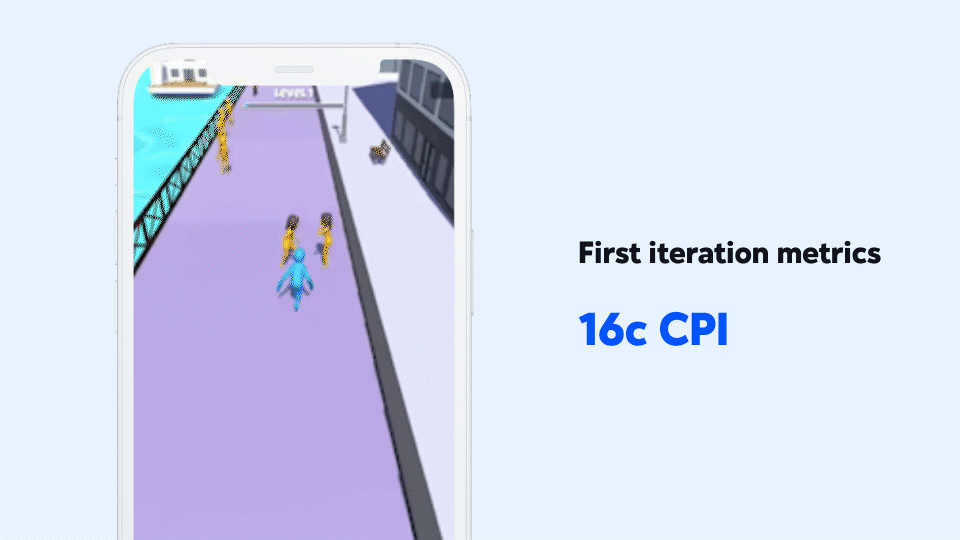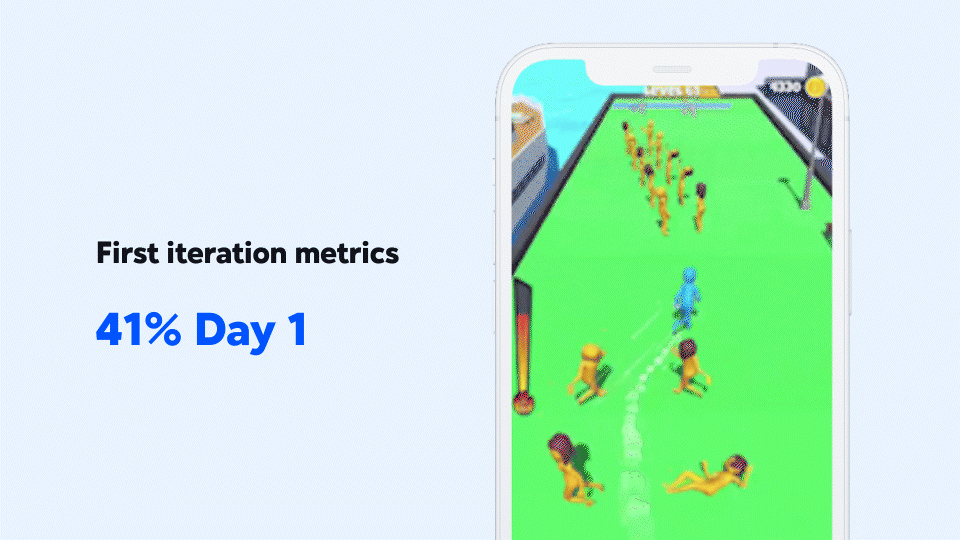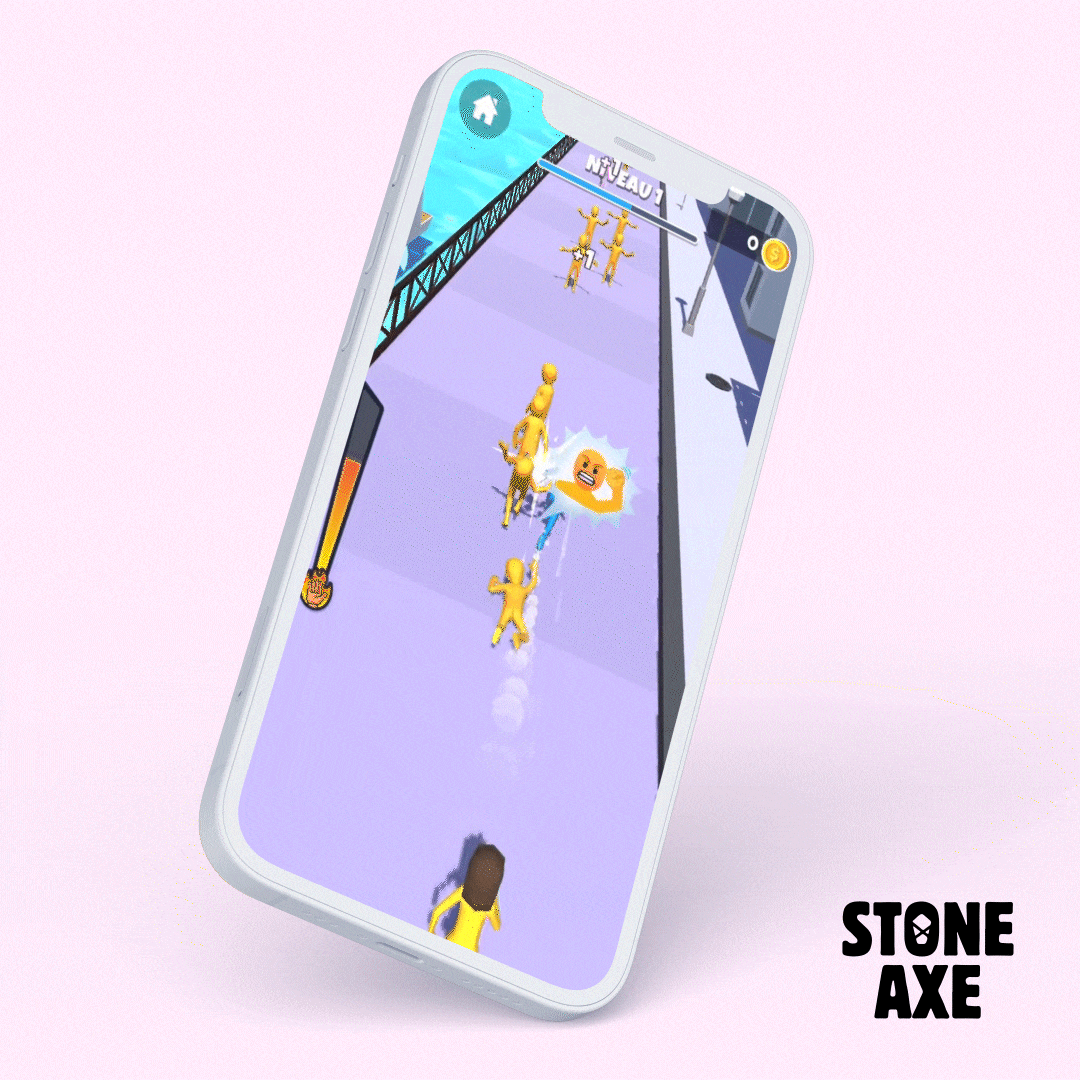Slap and Run is the latest hit game by Billy, a solo dev based in Mongolia, otherwise known as Stone Axe Studio. Since Billy started working with Voodoo back in 2018, he’s published one hit game per year, including Traffic Turn in 2019, Archer Warrior in 2020, Catch and Shoot in 2021, and now Slap and Run in 2022.
Slap and Run hit number 1 in the top charts in over 25 countries on iOS and Android, including the US. It rose to success thanks to a combination of high marketability and a challenging gameplay - a balance that isn’t always easy to achieve in the currently saturated runner segment. In a recent Voodoo Live stream with Billy and Publishing Manager Matthieu Lutz, the two discussed how Slap and Run achieved this dream combo. We’ll be sharing their insights on why exactly this game works so well today.

Game Mechanics
Slap and Run is a runner with a prank theme and slapping mechanic. You play as a running character with a left-right control that slaps figures walking past. Once slapped, these figures then form a mob that chases your character until you reach the end of the level. There are two ways to lose - being caught by the mob or running into obstacles, and there’s a strong feeling of risk/reward throughout the game. The more figures you slap, the bigger the mob will be, and consequently, the harder it is to get away. Your character can try and eliminate some of the mob by running close to obstacles that will get rid of them, but the closer you get, the harder it is to avoid being eliminated yourself.
There are actually six different challenges within the gameplay itself. The first is pretty straightforward; reach the end of the level without failing. The second is also pretty clear in the world of hyper-casual runners. There’s a level end in which you build up strength by slapping as many figures as you can, and the more you slap, the further you’ll kick the final character on the ruler board. Once you’ve completed each level, you’re given a number of stars out of three depending on how many figures you managed to slap throughout the level, as well as the exact number of figures slapped. This level-by-level feedback adds a challenge for players interested in mastering the game.
And if that wasn’t enough, the teams hid three extra challenges in the gameplay during the soft-launch phase. In certain levels, you’ll run past a shiny figure holding up a key. If you manage to collect it, you’ll be given a chance later in the game to open chests with extra rewards. In other levels, a pop-up will appear on the left side of the screen with an additional challenge: ‘Slap x1 cop’, ‘Slap x70 people’, for example. You don’t really get anything once if you achieve it, but it adds another layer of focus for the player in those specific levels and helps keep things fresh. Finally, at the end of each level, an automated leaderboard shows the ‘Total Slaps - Ranking’ worldwide. The more levels you play, the further up the ranking you go.
High marketability comes from a strong ideation process
Virality remains a big factor of success for runners this year. As the hyper-casual market becomes more and more saturated with runners, successful studios such as OHM Games and 501 have shown us that the key to creating viral games lies in a strong, methodological ideation process. One of our ideation techniques at Voodoo is called ‘Start from experience’, and Slap and Run is the perfect embodiment of this technique.
Billy: “The idea for Slap and Run came from a feeling that I remember from playing Grand Theft Auto games like Vice City when I was young. I really enjoyed running around and annoying people, then having them chase me. When looking at social media, I was also seeing a lot of prank videos all over the internet, so the idea suddenly popped into my head that this experience, this feeling, could work in a hyper-casual game. I did some market research and realised that there were no slap/runner games in the market, so I realised it could bring something fresh and original to players around the world”.
Matthieu: “Billy took the feeling of messing around that we see a lot in prank videos and turned it into a super satisfying, cathartic experience for the player. For each ideation technique we use, we have a specific checklist of things that studios should aim for when coming up with a hyper-casual idea. With the ‘start from experience’ technique, the three things we aim for are:
Universal appeal. Slap and Run’s cheeky prank side speak to basic human behaviour
Reminiscent of childhood games. The idea came from Billy reminiscing about how he felt when playing games like GTA, and this is a feeling that many people share
Addresses an urge. The game created adrenaline because it addresses an urge that cannot be addressed in real life.
Thanks to this ideation process, Billy managed to come up with a super marketable idea for Slap and Run. In just the first round of testing, the game hit a 16c CPI.
For more ideation techniques to help you come up with ideas for your next hits, head to our Ideation live stream on the Publishing Platform.

A challenging core gameplay comes from adding depth early on
As we saw earlier on, Slap and Run is full of different challenges to cater to a wide range of players, such as the casual player who is just looking for a few minutes of entertainment or the power user who is looking for more of a challenge and who will instinctively strive for the best score possible and complete all the levels. But creating a deep gameplay experience is not just about adding a variety of challenges to your game. According to Matthieu, there are three additional elements to the depth in Slap and Run:
A lower win rate. The first version of Slap and Run had a win rate of only 45%. “What’s interesting about win rates is that they used to be much lower a few years ago”, Matthieu states. “The typical win rate in 2018 was around 40%, and if we look at hit games like Helix Jump, we can see that it’s a challenging game! But the average win rate has progressively risen to around 66% these days, and if we look at the most successful runners of 2021, the win rate is more like 90%-95%. With Slap and Run, we’re back on a more classic win rate of under 50%, which is a blast from the past and shows that games with a challenging gameplay still have potential in today’s market”.
A strong risk/reward balance. The game is full of risks that lead to rewards. “The more people you slap, the bigger the mob chasing you will be. Given the win rate, you do die more frequently, but always because of something that you’ve triggered yourself. With the additional feedback at the end of each level, players that want to be challenged will go for a 100% completion rate, but on the other hand, players that just want a bit of fun don’t have to take the same risks but will still receive satisfaction throughout the level just by playing the game casually”.
Gameplay clarity. Challenging gameplay does not mean a game that is difficult to understand. Gameplay clarity is, in fact, even more important for games with a lot of depth. “In Slap and Run, both the gameplay and the ‘perfect run’ are super clear from the get-go. The figures you’re aiming for are all arranged in straight lines, and the path to follow is super clear, which means that users often aim for 100% completion. On top of that, the colour scheme is super obvious: your character is blue, opponents are purple, and obstacles are red. The game follows the ‘rule of three’ which we like to use when assessing whether the gameplay is clear enough - there are only three layers that you really need to understand to play the game, and these stand out instantly”.

Thanks to this gameplay depth, Slap and Run hit a 41% D1 in the first round of testing. With a 16c CPI and a 41% D1, the game was technically already publishable after the first iteration, but as the teams saw strong potential, they wanted to turn something promising into something great.
For more techniques on creating depth in your core gameplay, head to our High Playtime Tips live stream on the Publishing Platform.
What’s next for Stone Axe Studios
“It’s a blast to be working with Billy’, Matthieu states “he’s the perfect example of a strong developer; he’s super consistent in terms of how he prototypes, he systematically goes for full-fledged games for each test which means he really thinks through each idea, and he’s great at balancing games with a strong mechanic. With coaching in terms of coming up with high marketability ideas, he’s got all the keys to success”.
Billy: "I’ve been working with Voodoo since late 2018 and we maintained an excellent relationship in terms of how we approach making hit games. With Voodoo’s guidance and coaching, we were able to launch 4 games together, it’s been a real pleasure working with them. Overall, trying to make a better prototype after each test really helped me achieve this goal. We hope to make more hits in the future and I’m really looking forward to it!"
Watch the full live stream with Matthieu and Billy right here on our Publishing Platform.




